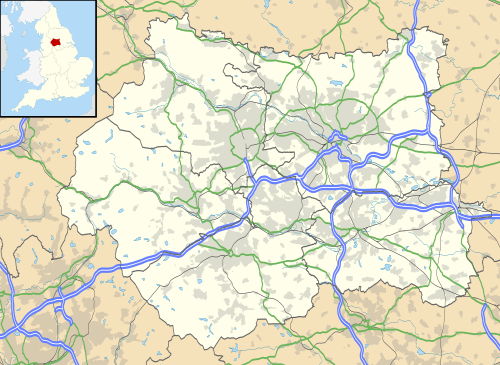Golcar
| Golcar | |
|---|---|
|
Golcar Village | |
 Golcar Golcar shown within West Yorkshire | |
| Population | 17,000 (2001)[1] |
| OS grid reference | SE1020015735 |
| District | |
| Shire county | |
| Region | |
| Country | England |
| Sovereign state | United Kingdom |
| Post town | HUDDERSFIELD |
| Postcode district | HD7 |
| Dialling code | 01484 |
| Police | West Yorkshire |
| Fire | West Yorkshire |
| Ambulance | Yorkshire |
| EU Parliament | Yorkshire and the Humber |
| UK Parliament | |
Golcar (pronounced 'Goker' or 'Golker': the 'L' is silent in local pronunciation) is a village on a hillside crest above the Colne Valley in West Yorkshire, England, 2.5 miles (4 km) west of Huddersfield, and just north of the River Colne and the Huddersfield Narrow Canal. At the time of the 2011 Census the population had increased to 18,033.[2] The main transport access is from the A62 (Manchester Road), through Milnsbridge in the valley bottom or via Scapegoat Hill from the A640 (New Hey Road) at the top of the hill.
The township of Golcar consisted of Bolster Moor, Golcar, Leymoor, Pole Moor, Scapegoat Hill and Town End.
History
Named after St Guthlac, who preached in the area during the 8th century, its name is recorded in the Domesday Book as Goullakarres. During the Industrial Revolution Golcar became an important centre for weaving. Pharmacologist James Burrows grew up in the area.
Colne Valley Museum
Three 1840s weavers' cottages were converted into the Colne Valley Museum in 1970. The museum has several restored period rooms which are used to show temporary exhibitions. The museum was extended in 2008 following the purchase of the adjoining former fish and chip shop.
Exhibits include a handloom and a spinning jenny, invented by James Hargreaves. In the loom chamber, spinning room, weavers sitting room and 'gas-lit' cloggers shop, the volunteer helpers give demonstrations of the type of crafts that would have existed during the 19th century.
The museum is run by volunteers and opens at weekends and bank holidays. Various craft and working weekends are held through the year.[3]
Community facilities
Golcar supports two scout groups: the 4th Golcar Scout Group, which was founded in 1951[4] and the 39th Parkwood Scout Group, founded in 1908.
The village has several sporting teams including football and cricket teams.
The vllage has two churches, the Anglican Parish Church of St John the Evangelist opened in 1829 [5] and is a good example of a Waterloo church and Golcar Baptist Church (), founded in 1835.
Each year in early May the village hosts the Golcar Lily Day.
Golcar Brass Band () was reformed in 1977 and practises at the Baptist Church on a Monday night.
Schools
- Golcar Junior, Infant & Nursery School, Manor Road, Golcar, Huddersfield HD7 4QE
- St. John's C of E Junior & Infant School, Leymoor Road, Golcar, Huddersfield HD7 4QQ
- Beech Primary, Beech Avenue, Golcar, Huddersfield HD7 4BE
- Wellhouse Junior & Infant School, Lower Wellhouse, Golcar, Huddersfield HD7 4ES
- Clough Head Junior & Infant School, Bolster Moor Road, Golcar, Huddersfield HD7 4JU
- Scapegoat Hill Junior & Infant School, School Road, Scapegoat Hill, Golcar, Huddersfield HD7 4NU
References
- ↑ www.kirklees.gov.uk
- ↑ "Kirkless Ward population 2011". Neighbourhood Statistics. Office for National Statistics. Retrieved 25 February 2016.
- ↑ Colne Valley Museum entry on Culture24. Retrieved 7 December 2009.
- ↑ 4th Golcar Scout Group
- ↑ The History of the Colne Valley, D.F.E. Sykes,1906. p187
Image gallery
- View of Golcar from Pike Law Road
- View of Bolster Moor from Pike Law Road